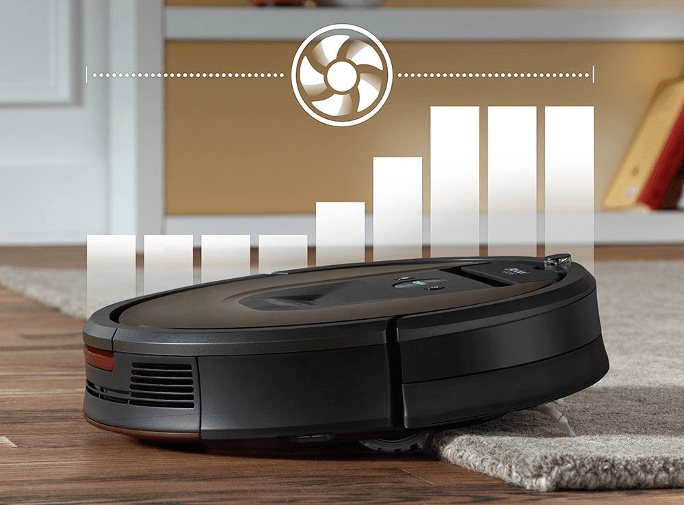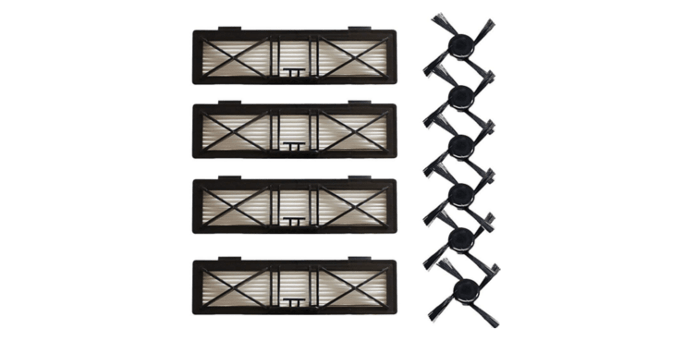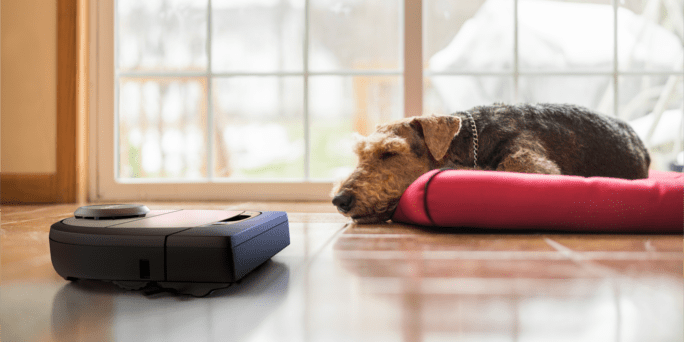There are tons of smart vacuums on the market at this point, with a variety of options at the low and mid price range. But what if you’re looking for the best of the best? The Neato D7 and Roomba 980 are some of the moire premium smart vacuums on the market, but the Neato D7 manages to outclass the Roomba at nearly every turn.
The main reason that the D7 comes out ahead is that it’s much better suited for working in large homes and across multiple floors. With support for multiple floor plans and virtual no-go zones through the app, it’s just all around a more flexible device than the Roomba.
With that said, the definitely has its charm. Read on below for a full breakdown of the similarities and differences when comparing the Neato D7 vs. Roomba 980. Alternatively, you can use the navigation bar in order to jump directly to the sections that interest you most.
Neato D7 vs. Roomba 980 — Things in Common
-
App Control – Both the Neato D7 and Roomba 980 use a WiFi app in order to schedule cleaning, initiate spot cleaning, and give notifications about the current cleaning. While both smartphone apps are quite capable, we do feel that the neato has a slight edge due to the ability to manually control the vacuum — a feature that isn’t common at all on smart vacuums.
-
Run Time – Both vacuums have an impressive battery life that allows for a run time of up to 120 minutes, which should be more than enough to clean the majority of homes.
-
Recharge & Resume – While the 120 minute battery life is more than enough to do a significant amount of cleaning, that life is extended even further due to the recharge and resume feature. When the vacuum’s power starts to get low, both the Neato D7 and Roomba 980 will head back to their base in order to charge. However, what sets these models apart from lower-end vacuums is the ability to pick up the cleaning where they left off as soon as they’ve topped up their battery life. This means that even for very large homes, the D7 and 980 should be able to clean each room during a single scheduled cleaning.
-
Side Brush – The early smart vacuums didn’t do a very thorough job of cleaning, leaving a trail of debris in their wake as they traveled around the room. That problem has since been addressed with the inclusion of side brushes that sweep dirt and dust into the line of suction. Both the Neato D7 and Roomba 980 feature a side brush that allows for a more thorough clean.
-
Mode – While the modes are named slightly differently, both the D7 and 980 have a “normal” mode for day-to-day cleaning, and a “strong” mode for those tough stains that need an extra power.
On the Roomba, the two modes are known as “Standard” and “Carpet Boost,” while the neato has the modes “Eco” and “Turbo.”
-
Voice Control – Last but not least, the Neato D7 and Roomba 980 support voice control through Amazon Alexa and Google Assistant. It’s a really useful functionality that allows you to easily control your vacuum without lifting a finger. Start a manual clean with a simple voice command, or call for spot cleaning while you’re cooking dinner or watching TV. It’s a feature that truly makes these smart robots feel smart.
Neato D7 vs. Roomba 980 — Differences

-
Difference #1: WiFi Connectivity – Since the Neato D7 and Roomba 980 use an app in order to send and receive data, they rely on WiFi connectivity. There are some differences in the types of frequencies that they support, with the Neato D7 being more flexible with 2.4GHz and 5GHz capabilities and the Roomba 980 only supporting 2.4 GHz.
If you have a 5GHz router, you’re pretty much limited to the Neato D7, so make sure you have an idea of your wireless tech before you make the buy.
-
Difference #2: Quick Charging – Both vacuums feature a recharge and resume functionality that allows the robots to top themselves off in the middle of a run before resuming where they left off. However, the Neato D7 features a quick charging capability called Quick Boost that gives the vacuum just enough power to finish the job. This means that your floors will be cleaner more quickly, as the Neato D7 won’t be spending as much time on the charging dock before heading back out on its regular schedule.
-
Difference #3: On-board Camera – A crucial part of the Roomba 980’s navigation technology is an on-board camera. This is an extremely low resolution camera, so you won’t have to worry about it spying on you, and it essentially functions to allow the Roomba to keep track of its location. This is a useful feature that makes for accurate tracking, but it does fall short in pitch black environments due to the lack of illumination. So if you’re planning to run your vacuum at night, the Roomba 980 might not be the best choice.
The Neato D7, on the other hand, relies solely on lasers in order to keep track of its location. We find this preferable to the camera, as it doesn’t have any reliance on lighting conditions.
-
Difference #4: Main Brush – Both the Neato D7 use a main brush in order to pick up dust and debris, but there are some significant differences in the way they are constructed.
The D7 features one of the highest-performing brushes on the market, with a wide, spiral combo brush that is perfect for homeowners with pets and sensitive allergies. It’s the gold standard for hair pick-up on floors of any type, and is also one of the best options for picking up dirt. In addition to its excellent cleaning capabilities, it also generates reduced noise and is an excellent solution for homes of multiple flooring types.
The Roomba 980 features a narrower, multi-surface brush that still does a good job of pulling in pet hair, dust, dirt and large debris without getting tangled. However, it falls short of the pure power that the D7’s spiral combo brush offers.
-
Difference #5: Multi Floor Plans – One of the main advantages of the Neato D7 when compared to the Roomba 980 is support for multiple floor plans. The Roomba is essentially limited to one floor, as it can only store one layout. The D7, on the other hand, can seamlessly transition between different floors with the capability to memorize the composition of multiple levels.
-
Difference #6: Wall Barrier – Both the Neato D7 and Roomba 980 support wall barriers, but they differ in the way that they approach blocking off specific areas.
The Neato D7 uses physical boundary markers that you can use to create a perimeter around certain parts of the room. But what really makes the D7 unique is its support for virtual no-go areas via the Neato app. Just draw a line across the floor map on your phone in order to restrict access. The D7 is way ahead of the competition when it comes to wall barriers, and the virtual no-go zones will really make you feel like you’re living in the future.
While the Roomba 980 Virtual Wall Barriers do a good job of blocking off entryways and spaces within the room, it doesn’t have the same flexibility or ease of use of the Neato’s virtual solution.
-
Difference #7: Filter – The Neato D7 and Roomba 980 both feature impressive filter technology that captures small particles that would otherwise get kicked up into the air. However, the Neato D7’s Ultra Performance filter is more capable than the High-Efficiency filter on the 980, capturing particles as small as 0.3 microns compared to the Roomba’s 10 microns.
Both vacuums do a good job of keeping dust and debris from getting released into the air during the vacuuming process, but those who are particularly sensitive to allergens might be better suited with the Neato D7 due to its more efficient filter.
-
Difference #8: Find Me – A pretty unique feature on the Neato D7 is the “Find Me” functionality. Smart vacuums generally do a pretty good job of finding their base when they run low on power. However, there may be situations from time to time where the vacuum gets stuck and is unable to travel back to its hub. In this situation, you might end up hunting for a dead vacuum, anad the Find Me feature makes that a whole lot easier. Just pull up the Neato app dashboard and press the robot icon. Your vacuum will beep for five seconds which should allow you to easily locate where it got itself stuck. If you can’t quite find it on the first go, just press the icon as many times as you need while hunting for the the robot’s location.
Unfortunately, the Roomba 980 has no such feature.
-
Difference #9: Manual Clean – One of the most unique smart vacuum features we’ve seen is the Neato D7’s manual clean mode. When you activate Manual clean, a bunch of a directional buttons will pop up on the app, allowing you to easily guide the vacuum around the room. Manual clean is especially useful when trying to clean specific areas, as you can easily target the parts of the room that need special attention without having to physically move the device for spot cleaning mode.
One thing to keep in mind with manual clean, however, is that the only active sensors on the robot in this mode are the front drop sensors. That means that if you move the robot backwards towards the stairs, it may take a tumble since it can’t detect ledges during that mode.
The Roomba 980 doesn’t allow for manual control. In fact, the vast majority of smart vacuum models only support automatic cleaning, so the Neato D7 is actually pretty unique as far as robot cleaners go.
-
Difference #10: Apple Watch Support – Both the Neato D7 and Roomba 980 support Amazon Alexa and Google Assistant voice control, but the D7 takes things a step further with support for Apple Watch. Being able to control your vacuum from wherever you are using your smart watch ensures you’ll never have to worry about taking out your phone or being in range of an Amazon Echo or Google Home.
The Roomba 980 does not support the Apple Watch.
-
Difference #11: Design – There is a significant difference in design between the two models. In terms of height and weight, they’re roughly comparable with the Neato D7 being 3.9 inches tall and weighing 7.5 pounds, and the 980 coming in at 3.6 inches and weighing 8.7 pounds.
The main difference between the two is that the Neato D7 has a unique D-shaped design that allows it to easily get into hard-to-reach areas for that optimal clean. The Roomba 980 has a standard round shape, which while effective, lacks the ability to get into some of the areas that the D7 cleans with ease.
Neato D7 vs. Roomba 980 — Comparison Chart
| Neato D7 | ||
|---|---|---|
| App Control | Yes | Yes |
| Run Time | Up to 120 min | Up to 120 min |
| Recharge & Resume | Yes | Yes |
| Quick Charging | Yes | No |
| On-board Camera | No | Yes |
| Main Brush | Spiral Combo Brush | Multi-Surface Brush |
| Side Brush | Yes | Yes |
| Mode | Eco & Turbo | Standard, Carpet Boost |
| Wall Barrier | Boundary Markers (2M) | Virtual Wall Barrier |
| Virtual No-go Areas via App | Yes | No |
| Cleaning Schedules | Yes | Yes |
| Voice Control | Alexa, Google Assistant | Alexa, Google Assistant |
| Apple Watch Support | Yes | No |
| WiFi Connectivity | 2.4Ghz + 5Ghz | 2.4GHz |
| Multi Floor Plans | Up to 3 | No |
| Coverage Maps | Yes | Yes |
| Filter | Ultra Performance | High Performance |
| Find Me | Yes | No |
| Height | 3.9 inches | 3.6 inches |
| Weight | 7.5 lbs. | 8.7 lbs. |
Neato D7 vs. Roomba 980 — Accessories

The Neato D7 and Roomba 980 both have some useful accessories that are great to have on hand in order to handle ongoing maintenance. From time to time you’re going to need to swap out parts in order to keep your vacuums running at maximum efficiency, as daily cleanings start to take their toll after a while.
For the Neato D7, it’s useful to have Ultra Performance Filters on hand since the filters are often the first things to go. The Neato Botvac D Series Brush Kit and the Side Brush Replacements will keep the actual cleaning mechanisms in tip top shape as well.
The Roomba 980 benefits from the Roomba 800 and 900 Series Replenishment kit, which is essentially an all-in-one package that gives you everything you need to keep your vacuum maintained. You might also be interested in a 3-pack of replacement AeroForce High-Efficiency Filters since those need replacing relatively frequently.
Outside of the maintenance aspect, Dual Mode Virtual Wall Barriers are an excellent addition to the vacuum if you have more areas that need to be blocked off, and an extra Integrated Home Base is always nice to have on hand to ensure your Roomba has easy access to a dock from wherever it happens to be.
Neato D7 vs. Roomba 980 — Our Thoughts

When comparing the Roomba 980 vs. Neato D7, there’s no denying that the Neato D7 is the superior choice. It exceeds the capabilities of the Roomba 980 in almost every area, and we see very little reason to ever recommend the 980 with how impressive the Neato D7 really is.
With unique features like manual mode, and high-tech options like virtual no-go areas and Multi Floor plans, it’s just difficult to beat for any big, multi level house. The is a very solid choice as well, but it frankly falls short of the awesome features that the Neato vacuum has to offer. Add to that Neato’s ongoing commitment to keeping older vacuums updated with new features for years to come, and we feel it’s truly a no-brainer.
Last update on 2024-04-18 at 13:11 / Affiliate links / Images from Amazon Product Advertising API


